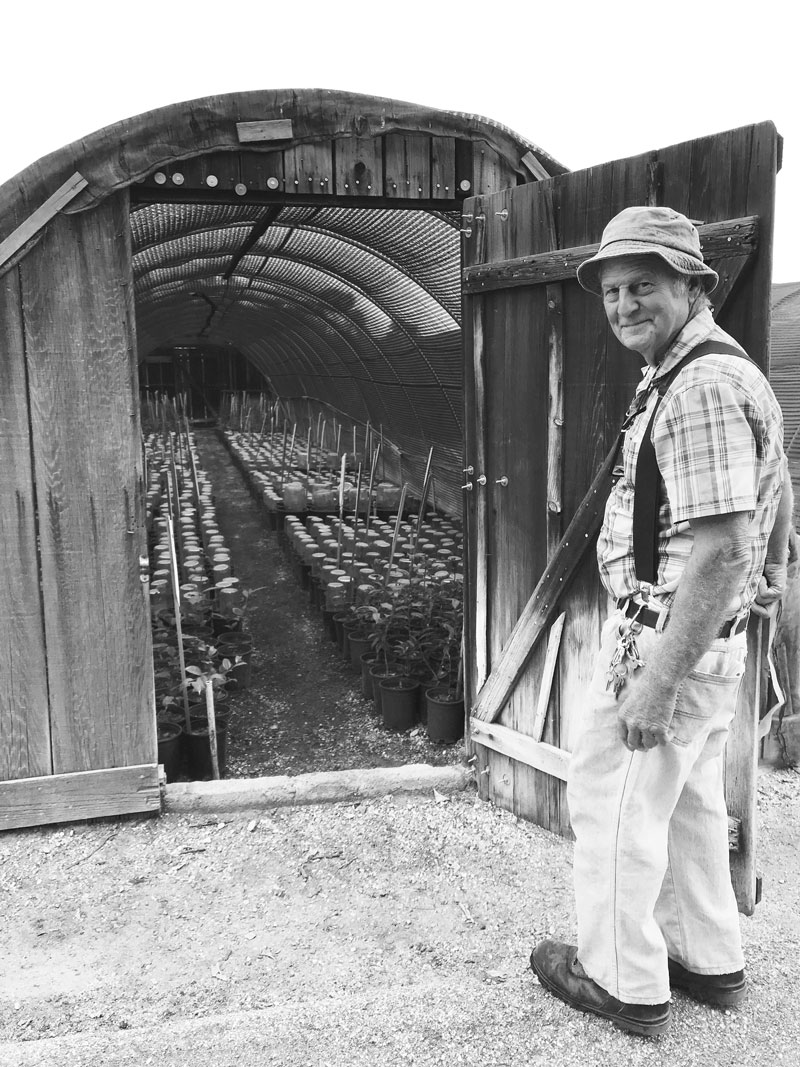Nuccio’s Nursery Over the Decades
A Love Affair with Camellias
By Val Zavala
Nuccio’s sits on 13 acres of slightly rising land on Chaney Trail, hugged by the chaparral above Loma Alta and Fair Oaks Avenues. With expansive views south, and the San Gabriels behind, there is a sense of timelessness about the upland site this nursery has occupied for 77 years. Stop by if you haven’t already, to meet Tom and Jim, and wander among seemingly endless varieties of camellias and azaleas.
Brothers Tom and Jim Nuccio, both now in their 70s, estimate there are 200,000 plants on their property —although they’ve never actually counted — and 600 kinds of camellias. Many were hybridized by the Nuccio family over two generations. Their nursery is world-renowned; they ship throughout North America, Europe and Japan.
Tom and Jim’s father Julius was 11 when he started growing camellias in his mother’s Alhambra backyard in the 1930’s. She got tired of moving her clothesline to accommodate her son’s plants, so in 1946 Julius’s father (Tom and Jim’s grandfather,) found 38 highland acres for sale in Altadena and bought it for $12,500 to grubstake his sons, Julius and brother Joe. The nursery takes up six of the site’s 13 flatish acres, with the balance of the land steep, gullied, and unusable. (In the early 70’s the family bought 40 more contiguous acres, but the nursery still uses the original six.)
Tom says, “My grandfather bought this property because it was affordable. He didn’t bother to check if it had water. So my dad approached the water company and asked if they could supply some.

Tom Nuccio at the door of one of many shade houses at the nursery.
They said, ‘We have plenty of water, but we don’t have any pipe.’ After WWII the metal was all used up.” Julius learned that a local character, a motorcycle hell-raiser type, might know where to get pipe and approached him. “The guy said. ‘Can you come up with a case of whiskey?’ The pipe showed up. No questions asked. The case of whiskey was gone.”
Water has flowed ever since, without any irrigation system. The thousands of plants are hand-watered with a wand on the end of a hose; there is quite an art to watering thousands of containers this way, according to Tom, who has trained generations of workers to do this crucial job correctly.
The Nuccios are expert propagators — hybridizing, growing, grafting, and selecting unique and beautiful new varieties. They have worked with Huntington Gardens which grows about 100 camellias they developed, including one named for Henry Huntington.
Propagating is a multi-year, slow-evolving process that cannot be sped up. Jim Nuccio says, “Camellias grown from seed will not bloom for roughly five years, depending. And when one does bloom and looks promising you have one plant. Then, usually by rooting cuttings (sometimes grafting) it takes five years to build the stock up. Tom explains that the whole time you’re evaluating when it blooms and if it has any idiosyncrasies — does it bloom early or late? does it set buds well or is slow to produce flower? So it takes about four or five years to really evaluate a new camellia.
One fun aspect about propagating their own varieties is naming them. Of course they named one for their grandfather, Julius Nuccio, and their grandmother Katie. Another of their favorites is Nuccio’s pearl.
Camellias are not just for beauty, you may be drinking some. “Our bestselling camellia is the Camellia senensis”, explains Jim. “It’s the least ornamental. So when you are drinking your basic Lipton or other black tea you are drinking camellia. Quite a few customers order 50 to 100 at a time to start a small tea plantation. It’s become our best-selling camellia.”
The business has served them well over decades. During COVID they noticed a uptick in local customers who had time to work on their gardens. Many were discovering the 77-year-old business for the first time. But like so many family businesses, successive generations have other interests — which is true of the younger Nuccios as well. So Jim and Tom will be selling the land and closing the much-loved family enterprise. What will become of the land is still undetermined. (Polytechnic school in Pasadena is interested in buying the land to build a sports facility. It has sparked a controversy that will be explored later by Altadena Heritage.)
The time will come when they step away from the six acres of camellias they have nurtured for decades. What will they miss most? “People are certainly up at the top,” said Tom. “But also seeing new varieties (of camellias) and new developments. If you get a hand-pollinated cross you get a new seedling. I’ll miss the new stuff that’s not out there yet.”
What will he not miss? “Well,” says Tom, “the days aren’t long enough to get things done. You fool around with other things and you don’t get the thing done you set out to do. I won’t miss the frustration of always being behind.”
As for Jim, “I will miss the people, especially new customers and new audiences for my oblique sense of humor. But I won’t miss the frequent driving trips in the van to deliver plants up to the Bay area, although my wife and I know all the good restaurants between here and San Francisco.”
The world of camellia growers will miss Tom, Jim, and Nuccio’s nursery, and Altadena will miss knowing that there is a world of choice and cheerful help and advice. With tremendous horticultural knowledge, skill, and decades of time, they have introduced 210 new varieties, winning the prestigious Camellia Propagators award 13 times.
But the award we Altadenans would likely give the Nuccios would be a prize for decades of wonderful service, making our community stronger, and our gardens more beautiful.
